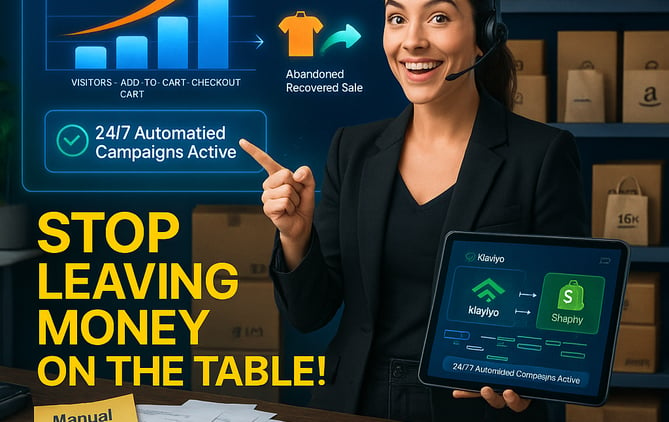How Marketing Automation Can Skyrocket Your E-commerce Conversions
Discover how marketing automation can transform your e-commerce business by increasing conversions, improving efficiency, and enhancing customer experiences.
MARKETING AUTOMATION
6/5/20253 min read


Introduction
In the fast-paced world of e-commerce, staying ahead of the competition requires more than just great products—it demands smart, efficient, and personalized marketing strategies. This is where marketing automation comes in.
Marketing automation allows you to streamline repetitive tasks, deliver personalized experiences, and nurture leads at scale. The result? Higher conversions, improved customer retention, and a significant boost to your bottom line. In this article, we’ll explore how marketing automation can skyrocket your e-commerce conversions and provide actionable tips to get started.
What is Marketing Automation?
What It Is: Using software to automate repetitive marketing tasks like email campaigns, social media posts, and ad targeting.
Why It Matters: Automation saves time, reduces errors, and ensures consistent engagement with your audience.
Examples of Marketing Automation:
Sending personalized emails based on user behavior.
Retargeting website visitors with ads.
Automating social media posts and responses.
How Marketing Automation Boosts E-commerce Conversions
Here’s how marketing automation can transform your e-commerce business:
1. Personalized Customer Journeys
What It Is: Tailoring marketing messages based on individual customer behavior and preferences.
Why It Matters: Personalization increases engagement and makes customers feel valued.
How to Implement:
Use automation tools to segment your audience based on purchase history, browsing behavior, or demographics.
Send personalized product recommendations or exclusive offers.
Create dynamic email campaigns that adapt to user actions.
Pro Tip: Use platforms like Klaviyo or HubSpot for advanced personalization features.
2. Abandoned Cart Recovery
What It Is: Automatically reminding customers who leave items in their cart without purchasing.
Why It Matters: Abandoned cart emails can recover up to 30% of lost sales.
How to Implement:
Set up automated emails that trigger when a cart is abandoned.
Include product images, a clear CTA, and a sense of urgency (e.g., “Your cart is expiring soon!”).
Offer incentives like discounts or free shipping to encourage completion.
Pro Tip: Test different email timings and messaging to optimize recovery rates.
3. Lead Nurturing
What It Is: Automating follow-ups to guide potential customers through the buying process.
Why It Matters: Nurtured leads are more likely to convert into paying customers.
How to Implement:
Create a series of automated emails that educate leads about your products or services.
Use lead scoring to prioritize high-value prospects.
Offer free resources like eBooks or webinars to build trust.
Pro Tip: Use tools like ActiveCampaign or Marketo for advanced lead nurturing workflows.
4. Retargeting Campaigns
What It Is: Automatically showing ads to users who have interacted with your site but didn’t convert.
Why It Matters: Retargeting keeps your brand top of mind and encourages users to return.
How to Implement:
Use platforms like Google Ads or Facebook Ads to set up retargeting campaigns.
Segment audiences based on their behavior (e.g., viewed product, added to cart).
Create compelling ad creatives that highlight your unique selling points.
Pro Tip: Use dynamic retargeting ads to show users the exact products they viewed.
5. Post-Purchase Engagement
What It Is: Automating follow-ups after a purchase to build loyalty and encourage repeat business.
Why It Matters: Engaged customers are more likely to make repeat purchases and recommend your brand.
How to Implement:
Send thank-you emails with order details and delivery updates.
Request reviews or feedback to build social proof.
Offer exclusive discounts or rewards for future purchases.
Pro Tip: Use automation to upsell or cross-sell related products after a purchase.
Real-World Example: How Automation Boosted Conversions
Let’s look at a real-world example of how marketing automation helped an e-commerce brand:
The Problem:
An online fashion retailer struggled with low conversion rates and high cart abandonment.
The Solution:
They implemented marketing automation tools to send personalized emails, recover abandoned carts, and retarget website visitors.
The Results:
The retailer saw a 40% increase in conversions and a significant reduction in cart abandonment rates.
Conclusion
Marketing automation is a game-changer for e-commerce businesses, enabling you to deliver personalized experiences, recover lost sales, and nurture leads at scale. By leveraging automation tools, you can skyrocket your conversions, improve efficiency, and drive long-term growth.
Start exploring marketing automation today, and take your e-commerce business to the next level!
